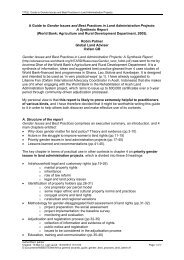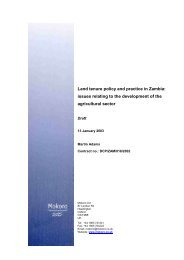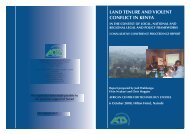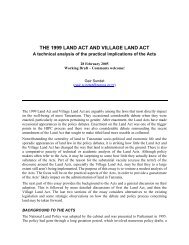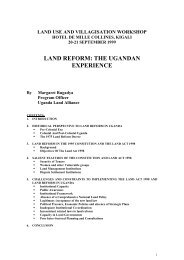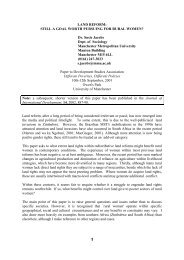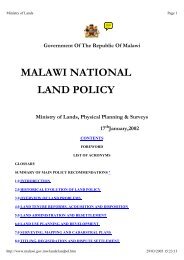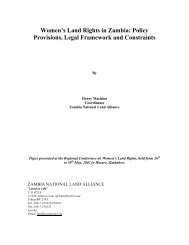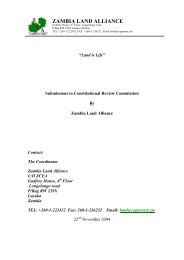Download - Mokoro
Download - Mokoro
Download - Mokoro
- No tags were found...
You also want an ePaper? Increase the reach of your titles
YUMPU automatically turns print PDFs into web optimized ePapers that Google loves.
34the systems that created privilege, state intervention in favour of small-scale andresource-poor farmers has tended to be on a “project” basis rather than intervening inmarkets.The state has taken a number of initiatives to support land reform beneficiaries, amongother ‘emerging’ farmers and small farmers in communal areas, all of which have beenseriously under-funded. The Broadening Access to Agriculture Thrust (BATAT) of themid-1990s, including farmer support and production loans, failed to materialise, and theFarmer Settlement Programme (FSP) responsible for post-transfer agricultural supporthad no national capital budget until 2004, though in some provinces infrastructure grantswere provided (Jacobs 2003). The FSP has now risen to 18% of the national budget foragriculture and remains, true to its name, a farmer settlement system, with limited reach,rather than a mechanism for restructuring the economic and market environment for newentrants (National Treasury 2007).The key framework for providing agricultural support to new farmers is now theComprehensive Agricultural Support Programme (CASP) established in 2004 for‘emerging farmers’ and allocated R750 over medium term expenditure framework(MTEF). A recent review of CASP found that, in most regions, infrastructure was the onlyform of support provided, coordination with the land reform process was inadequate andthat, despite high levels of demand, there was under-spending due to bureaucraticprocurement procedures (DOA 2007). Support in the form of technical advice, training,marketing, production inputs and risk management had been largely ignored byimplementers, and while some land reform beneficiaries got access to CASP funds, insome areas officials directed these away from land reform towards emerging farmersconsidered to be more commercially oriented (DOA 2007:45). Contrary to its name,then, CASP is far from comprehensive, both in the types of support made available, andin its reach to those it targets. The review points out some of the inherent limitations ofthe grant-based model of support, which appears to be modeled on LRAD. It concludedthat CASP would need to be revised and would need to be “couched within a commonvision of land and agrarian reform that is shared by agriculture and land affairs(nationally and provincially)” (DOA 2007:2).A further area in which support has been somewhat reintroduced is credit. As the LandBank was restructured to become self-financing, albeit with a “development mandate”, itintroduced market-related interest rates and now provides preferential lending only onthe slightly discounted Special Mortgage Bond (SMB). It also administers the MicroAgricultural Finances Institutions of South Africa (MAFISA), for which it does receivebudgetary transfers. MAFISA, presented as a new version of the Agricultural CreditBoard, was capitalised with nearly R1 billion over the MTEF in 2005/06, and is availableonly to black South Africans with gross off-farm incomes below R20,000 a month (DOA2005). By 2007, 900 applications had been approved, and CASP had supported projectswith a total membership of 67,366 (National Treasury 2007). At the most generousestimate, this suggests that certainly less than one in ten land reform beneficiaries hasaccess to either of these facilities, and while CASP funding is projected to rise, othercrucial budget lines for the Department of Agriculture are in decline (see table 4 below).Policy Options for Land and Agrarian ReformProgramme for Land and Agrarian Studies, University of the Western Cape




